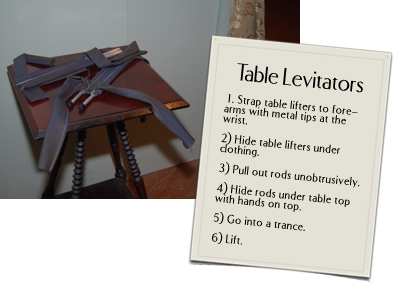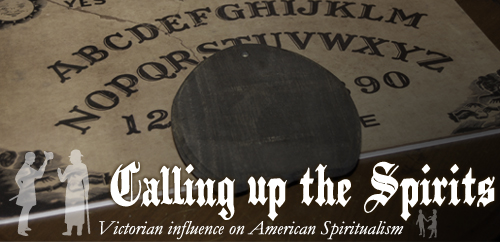
|
American Spiritualism is
“completely Victorian,” according to Elan Zingman-Leith, curator for the
Mid-Atlantic Center for the Arts (MAC). And it all began with the Fox sisters up
in Hydesville, New York in 1848. Strange noises – knockings and rappings – were
coming from the bedroom of John and Margaret Fox’s two youngest The girls answered all the neighbors’ questions – why wouldn’t they? It was a small town and they were intimately familiar with its comings and goings. The publicity surrounding their strange ability to go into a trance and call on the spirits of the dead aroused the attention of their older sister, Leah (Fox) Fish, living in Rochester, New York. Leah knew a good thing when she
saw it and made the sisters famous. On November 14 at Corinthian Hall in
Rochester, Katie and Maggie called upon the spirits in front of an electrified
audience of 400 people. Several investigative committees were formed to look
into The Rochester Rappings and found the girls to be credible mediums.
Their spiritual forays came to the attention of the very influential New York
Tribune editor, Horace Greeley, who recently lost his youngest son,
Eventually, many years later, Kathy and Maggie confessed that the “knockings” came from apples the girl tied to a string and dropped to the floor. The “rappings” came from a talent the girls had acquired – they could make rapping noises by flexing the joints of their big toes. They wanted to give up the charade long before. In fact, the first “knocking-rappings” were heard in March of 1848 and by November the sisters had tired of the attention and announced that the “spirits had left them.” But their sister, Leah who saw the fortune that could be made, wouldn’t hear of it and so the spirits returned.
At MAC, Elan noticed that ghost
writer Craig McManus’s appropriately titled Ghostwriter
Trolley Rides were so popular that MAC added more tours involving ghosts
- Tale of Terror Trolley Ride, Miss Parmentier’s Psychic
Teas, Historic Haunts Combination Tours, Phantoms of the Physick Estate. It
seemed people couldn’t get enough of the spirit world and it got him to
thinking: Why were the Victorians so enthralled with “the other plane?” He came
up with a few ideas on that very subject and it has been
the topic of an ongoing
exhibit at the Carriage House of the Emlen Physick Estate on Washington Street
called The Other Side: The World of
Victorian Spiritualism which ends
Nov. 9. The exhibit explores the world of séances, Ouija boards, fairies
and ectoplasm through photographs and artifacts and shows why the Victorian
Although interest in Spiritualism began before the Civil War, it really took off after the war in which at least 618,000 Americans died. Some experts say the toll reached 700,000. “So many people lost family members, especially teenagers, in the Civil War,” said Elan, “To believe that death was not so final and that their loved ones were still among us, but just on another plane, was one way to deal with death.” Elan found the growth of
Spiritualism curious because it “did not come out of either Protestant or Jewish
theology,” but seemed propelled by people grieving their losses from the war
coupled by a burgeoning interest in modern science and Darwinism which developed
in the mid-19th century. “People for the first time were,” according
to Elan, “beginning to look at the Bible symbolically and perhaps not reading
the scripture quite as literally.” In so doing, he said, it appears as though
they were
It is then no coincidence that this was a time for new religions popping up. Western New York and the Boston area seemed to be the “hot spots” for their beginnings. Mary Baker Eddy’s the First Church of Christ, Scientist of Boston (Christian Science) was founded in 1879. In western New York, The Church of Latter Day Saints was founded in 1860 by Joseph Smith, Jr. The Theosophical Society of New York was founded by Madame Helena Blavatsky (a famous medium of the time) and Colonel H.S. Olcott in 1875. The pair threw themselves into the defense of reality of spiritualistic phenomena while attempting to purify the spiritualistic movement of its materialistic trend. One odd thing about Madame Blavatsky, according to Elan, even when she was “found out,” in other words, when someone spotted the “trick” in one of her performances, she unabashedly would admit the ruse, maintaining she didn’t care, she “did it for your own good.” The role of the medium was one of
the few times when a woman of Victorian America could make a name for herself
and not fall under ill repute. Unlike actresses and singers, a medium was
well-respected and could earn a significant income. Séances were common forms of
entertainment in the most distinguished of parlors.
Don’t miss it – it’s a fascinating exhibit especially if combined with one of the ghostly tours. A sneak peek at the exhibit:
|
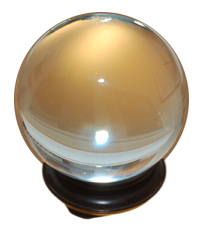 daughters,
Katherine, age 11, and Margaretta, 13. Mrs. Fox heard the noises and came to the
conclusion that they must be spiritual in nature. She brought the neighbors in
to question the girls. Had disembodied spirits taken hold of them and if so,
what information did the girls have of those “on the other plane” obviously so
intent on making their presence known using these two young girls as their
“medium”?
daughters,
Katherine, age 11, and Margaretta, 13. Mrs. Fox heard the noises and came to the
conclusion that they must be spiritual in nature. She brought the neighbors in
to question the girls. Had disembodied spirits taken hold of them and if so,
what information did the girls have of those “on the other plane” obviously so
intent on making their presence known using these two young girls as their
“medium”?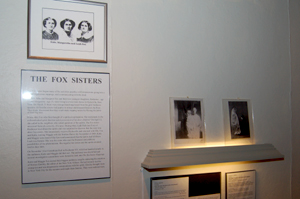 and was
desperate to “contact” him. He was so impressed with the sisters he brought them
to New York and made them national stars.
and was
desperate to “contact” him. He was so impressed with the sisters he brought them
to New York and made them national stars.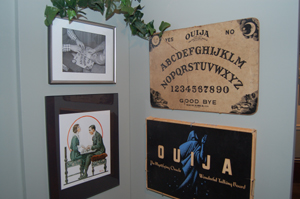 world was so fascinated by mediums and psychics and includes the story of the
Fox sisters and several other noted mediums of the time.
world was so fascinated by mediums and psychics and includes the story of the
Fox sisters and several other noted mediums of the time.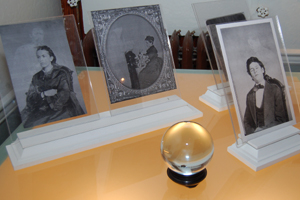 disillusioned, particularly with the Protestant religion, and were
looking around for alternatives “and some found that alternative in the world of
spirits and the other plane.”
disillusioned, particularly with the Protestant religion, and were
looking around for alternatives “and some found that alternative in the world of
spirits and the other plane.”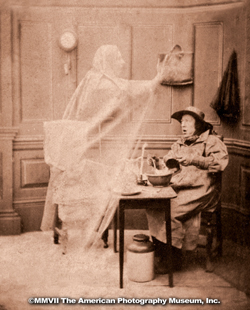 Unless someone was
particularly religious and man of the cloth, most people did not seem the harm
in “calling up the spirits.” And that popularity, curiosity and a genuine need
to reconnect with the dead on top of the money to be made if you “had the gift”
helped spawn some of the greatest con men/women of the time. Some of the tools
of the trade are also on display. So, if you get a chance walk on down to the
Carriage House, for the mere pittance of a $2 donation, you too can discover how
to levitate tables and throw your voice across the room. Imagine. It all began
with the Victorians, who so desperately wanted to believe. Séances, Ouija
boards, spirit writing, levitation, spirit photography, trances and the mediums
to connect the spirit world with the living began in the mid-19th
century America.
Unless someone was
particularly religious and man of the cloth, most people did not seem the harm
in “calling up the spirits.” And that popularity, curiosity and a genuine need
to reconnect with the dead on top of the money to be made if you “had the gift”
helped spawn some of the greatest con men/women of the time. Some of the tools
of the trade are also on display. So, if you get a chance walk on down to the
Carriage House, for the mere pittance of a $2 donation, you too can discover how
to levitate tables and throw your voice across the room. Imagine. It all began
with the Victorians, who so desperately wanted to believe. Séances, Ouija
boards, spirit writing, levitation, spirit photography, trances and the mediums
to connect the spirit world with the living began in the mid-19th
century America. 